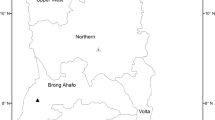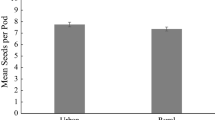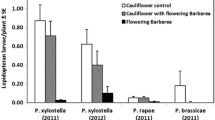Abstract
Biocontrol agents released to control exotic pests may not have the same spatial distribution as the pest species and may therefore vary in efficacy across the exotic range. These changes in distribution are unlikely to be known until species have had time to fill all preferred niches in the invasive habitat. However, studies of post-release activity of biocontrol agents rarely assess longer-term patterns of establishment in the landscape. Comostolopsis germana and Mesoclanis polana were released to control Chrysanthemoides monilifera spp. rotundata (bitou bush) between 29 and 32 years ago. We assessed their activity in foredune and hinddune habitats of coastal beaches across the major distribution of bitou bush and experimentally assessed the effectiveness of C. germana at preventing flowering and seed set. Both biocontrol agents were found to be distributed along the 870 km of coastline, representing the core area of infestation. Tip damage by C. germana was highly variable but was consistently more effective in the foredune. Comostolopsis germana was found to reduce flower production from 15 to 59% with tip damage increasing with latitude. Mesoclanis polana did not show differences in activity with latitude and only showed a marginal increase in activity in hinddunes. Comostolopsis germana and M. polana are reducing the reproductive output of bitou bush but are unlikely to be effective as a sole management strategy particularly in warmer latitudes where more seeds are released.






Similar content being viewed by others
References
Adair RJ, Scott JK (1989) The life-history and host specificity of Comostolopsis germana Prout (Lepidoptera: Geometridae), a biocontrol agent of Chrysanthemoides monilifera (Compositae). Bull Entomol Res 79:649–657
Barton J, Fowler SV, Gianotti AF, Winks CJ, de Beurs M, Arnold GC, Forrester G (2007) Successful biological control of mist flower (Ageratina riparia) in New Zealand: agent establishment, impact and benefits to the native flora. Biol Control 40:370–385
Briese DT (2000) Classical biological control. In: Sindel B (ed) Australian weed management systems. Richardson Publishing, Melbourne, pp 161–192
Briese DT (2004) Weed biological control: applying science to solve seemingly intractable problems. Aust J Entomol 43:304–317
Broennimann O, Treier UA, Muller-Scharer H, Thuiller W, Peterson AT, Guisan A (2007) Evidence of climatic niche shift during biological invasion. Ecol Lett 10:701–709
Clewley GD, Eschen R, Shaw RH, Wright DJ (2012) The effectiveness of classical biological control of invasive plants. J Appl Ecol 49(6):1287–1295
DEC (Department of Environment and Conservation) (2006) NSW threat abatement plan invasion of native plant communities by Chrysanthemoides monilifera (bitou bush and boneseed). Department of Environment and Conservation (NSW), Hurstville
Dhileepan K (2002) Evaluating the effectiveness of weed biocontrol at the local scale. In: Spafford JH, Briese DT (eds) Improving the selection, testing and evaluation of weed biological control agents. CRC for Australian weed management technical series 7. Proceedings of the CRC for weed management biological control of weeds symposium and workshop. CRC for Australian Weed Management, Glen Osmond, pp 51–60
Downey PO, Holtkamp RH, Ireson JE, Kwong RM, Swirepik AE (2007) A review of the Chrysanthemoides monilifera biological control program in Australia: 1987–2005. Plant Prot Q 22:24–32
Edwards PB, Holtkamp RH, Adair RJ (1999) Establishment and rapid spread of bitou seed fly, Mesoclanis polana Munro (Diptera: Tephridae), in eastern Australia. Aust J Entomol 38:148–150
Edwards PB, Adair RJ, Holtkamp RH, Wanjura WJ, Bruzzese AS, Forrester RI (2009) Impact of the biological control agent Mesoclanis polana (Tephritidae) on bitou bush (Chrysanthemoides monilifera subsp. rotundata) in eastern Australia. Bull Entomol Res 99:51–63
Ens EJ, Bremner JB, French K, Korth J (2009) Identification of volatile compounds released by roots of an invasive plant, bitou bush (Chrysanthemoides monilifera spp. rotundata), and their inhibition of native seedling growth. Biol Invasions 11:275–287
French K, Mason TJ, Sullivan N (2010) Recruitment limitation of native species in invaded coastal dune communities. Plant Ecol 212:601–609
Gallagher RV, Beaumont LJ, Hughes L, Leishman MR (2010) Evidence for climatic niche and biome shifts between native and novel ranges in plant species introduced to Australia. J Ecol 98:790–799
Ghosheh HZ (2005) Constraints in implementing biological weed control: a review. Weed Biol Manag 5:83–92
Hill RL, Wittenberg R, Gourlay AH (2001) Biology and host range of Phytomyza vitalbae and its establishment for the biological control of Clematis vitalba in New Zealand. Biocontrol Sci Technol 11:459–473. https://doi.org/10.1080/09583150120067490
Hoffmann JH, Moran VC (1992) Oviposition patterns and the supplementary role of a seed-feeding weevil, Rhyssomatus marginatus (Coleoptera: Curculionidae), in the biological control of a perennial leguminous weed, Sesbania punicea. Bull Entomol Res 82(343–347):343
Hoffmann JH, Moran VC (1998) The population dynamics of an introduced tree, Sesbania punicea, in South Africa, in response to long-term damage caused by different combinations of three species of biological control agents. Oecologia 114:343–348
Holtkamp RH (2002) Impact of bitou tip moth, Comostolopsis germana, on bitou bush in New South Wales. In: Spafford JH, Dodd J, Moore J (eds) 13th Australian weed conference, Perth. Plant Protection Society of WA, South Perth, pp 405–406
Ireson JE, Gourlay AH, Kwong RM, Holloway RJ, Chatterton WS (2003) Host specificity, release, and establishment of the gorse spider mite, Tetranychus lintearius Dufour (Acarina: Tetranychidae) for the biological control of gorse, Ulex europaeus L. (Fabaceae) in Australia. Biol Control 26:117–127
Julien M, McFadyen R, Cullen J (eds) (2012) Biological control of weeds in Australia. CSIRO Publishing, Melbourne
Keane RM, Crawley MJ (2002) Exotic plant invasions and the enemy release hypothesis. Trends Ecol Evol 17:164–170
Lindsay EA, French K (2004) Chrysanthemoides monilifera ssp. rotundata invasion alters decomposition rates in coastal areas of south-eastern Australia. For Ecol Manage 198:387–399
Martin GD, Coetzee JA, Weyl PSR, Parkinson MC, Hill MP (2018) Biological control of Salvinia molesta in South Africa revisited. Biol Control 125:74–80
Mason TJ, French K, Russell KG (2007) Moderate impacts of plant invasion and management regimes in coastal hind dune seed banks. Biol Cons 134:428–439
Mason TJ, French K, Russell K (2012) Are competitive effects of native species on an invader mediated by water availability? J Veg Sci 23:657–666
Moran VC, Hoffmann JH, Zimmermann HG (2013) 100 years of biological control of invasive alien plants in South Africa: history, practice and achievements. S Afr J Sci 109:1–6
Morin L, Reid AM, Sims-Chilton NM, Buckley YM, Dhileepan K, Hastwell GT, Nordblom TL, Raghu S (2009) Review of approaches to evaluate the effectiveness of weed biological control agents. Biol Control 51:1–15
Norambuena H, Martínez G, Carrillo R, Neira M (2007) Host specificity and establishment of Tetranychus lintearius (Acari: Tetranychidae) for biological control of gorse, Ulex europaeus (Fabaceae) in Chile. Biol Control 40:204–212
Story JM, Smith L, Corn JG, White LJ (2008) Influence of seed head–attacking biological control agents on spotted knapweed reproductive potential in western Montana over a 30-year period. Environ Entomol 37:510–519
Stuart R, Kriticos DJ, Ash JE (2002) Modelling the biological control of bitou bush (Chrysanthemoides monifera: Asteraceae) by Mesoclanis polana (Tephritidae). In: Spafford JH, Dodd J, Moore JH (eds) 13th Australian weeds conference proceedings: weeds ‘threats now and forever’. Plant Protection Society of WA, Perth, Australia, pp 591–594
Thomas J, Leys A (2002) Strategic management of bitou bush (Chrysanthemoides monilifera ssp. rotundata (L.) T.Norl.). In: Spafford JH, Dodd J, Moore JH (eds) 13th Australian weeds conference proceedings: weeds ‘threats now and forever’. Plant Protection Society of WA, Perth, Australia, pp 586–590
Weiss PW (1984) Seed characteristics and regeneration of some species in invaded coastal communities. Aust J Ecol 9:99–106
Winkler MA, Cherry H, Downey PO (2008) Bitou bush management manual: current management and control options for bitou bush (Chrysanthemoides monilifera ssp. rotundata) in Australia. Department of Environment and Climate Change (NSW), Sydney
Acknowledgements
We thank the University of Wollongong for supporting this work.
Author information
Authors and Affiliations
Corresponding author
Additional information
Publisher's Note
Springer Nature remains neutral with regard to jurisdictional claims in published maps and institutional affiliations.
Electronic supplementary material
Below is the link to the electronic supplementary material.
Rights and permissions
About this article
Cite this article
French, K., Barrett, K.L. & Watts, E. The fickle activity of a fly and a moth: variation in activity of two biocontrol agents of Chrysanthemoides monilifera. Biol Invasions 21, 1807–1815 (2019). https://doi.org/10.1007/s10530-019-01936-8
Received:
Accepted:
Published:
Issue Date:
DOI: https://doi.org/10.1007/s10530-019-01936-8




